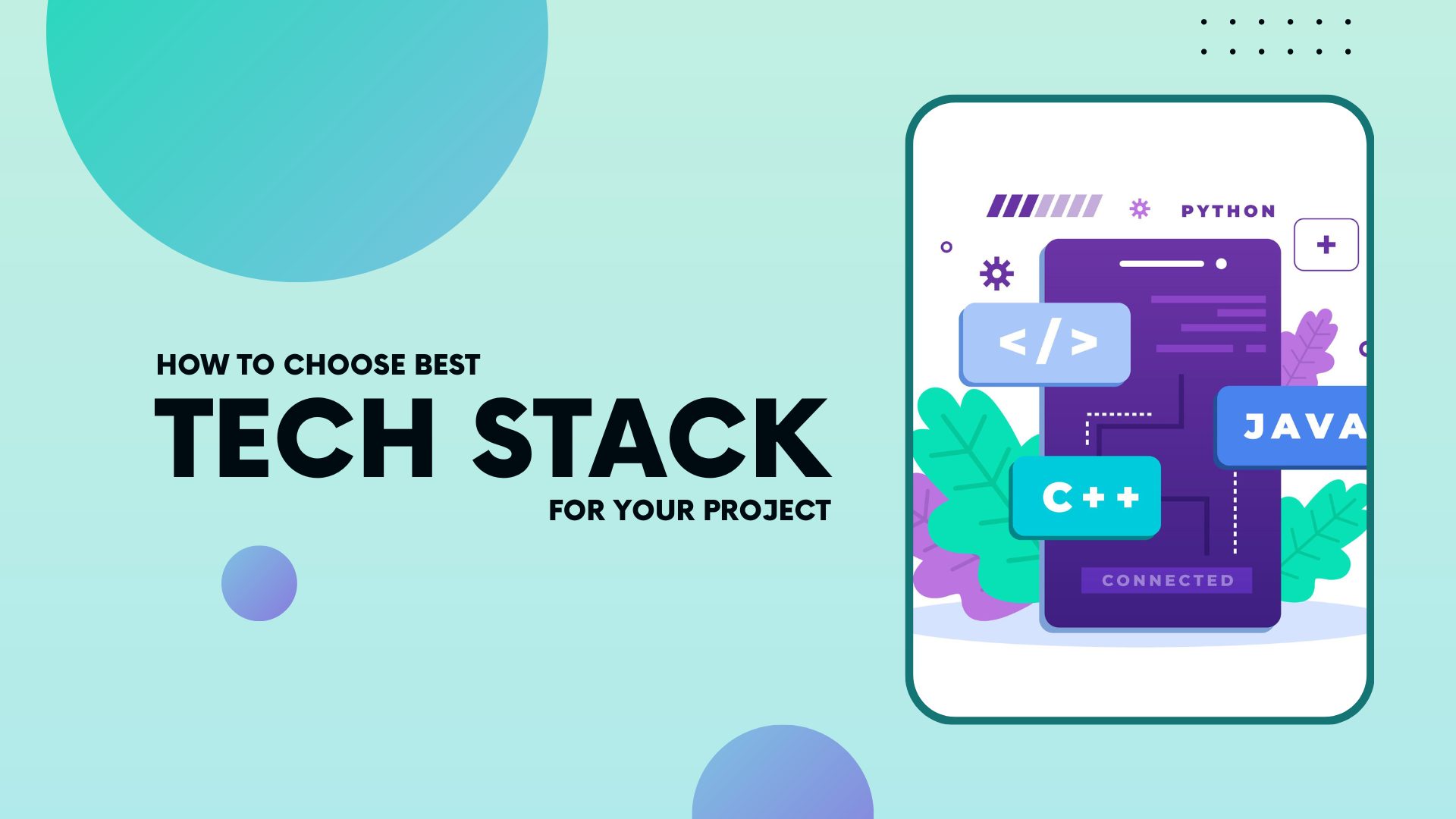Article content
Introduction
Are you unfamiliar with programming languages? In that case, the concept of the tech stack can be challenging for you to understand. But, to know what you need to build a business website or an application, it’s essential to understand what is a tech stack first. Once you get that, you must then put your mind to selecting the right tech stack for your project. This blog will walk you through everything there is to learn about a tech stack. So, keep reading!
What is a Tech Stack?
A builder needs a lot of materials to build a house. Similarly, a tech stack meaning is a combination of all the technologies (materials). A company uses them to develop and run an application. It is often referred to as a solutions stack. Hence, a technology stack usually consists of the following:
- programming languages
- frameworks
- a database
- front-end technologies and tools
- back-end development tools
- applications connected via APIs
In the case of product companies, it usually consists of tools that help measure the product and user analytics.
What is the Structure of a Tech Stack?
An application has a double software mechanism. 1 is the client’s side, and the other is the server side. You would know them as the front-end stack and the back-end. Note that each layer of an application is built using various functionalities and creating a technical stack. The middleware acts like a transition layer. It links the front-end development and the back-end languages and components. Moving ahead, we discuss all these components to give you a better understanding of them.
Technology Stack in Front-End Development
Be clear about one thing; the users interact with the client side of the product. This is the visual side of your product. Examples of front-end stack:
- JavaScript – makes web pages more interactive. It lets you construct dynamic elements on web pages.
- HTML – used to create and display electronic documents.
- CSS – it is in charge of page layout and format. (Sizes, font styles, design, color, and other web development elements.)
Technology Stack in Back-End Development
This is the invisible part of the product. This includes the technologies that operate in the background. Thus, this part stores and handles data. Moreover, it also processes and responds to incoming requests. Furthermore, it allows the front end to achieve its goal. Hence, the back-end stack includes the following technologies:
- Programming languages
- Databases
- Frameworks and Libraries
- Web Servers
- Cloud Infrastructures
Technology Stack in Mobile App Development
There are a few programming languages and frameworks only suitable for building applications. Be it Android or iOS. Furthermore, here is a list of technologies used for Android and iOS:
For Android:
- Standard programming languages – Java, Kotlin
- Android Studio, Android SDK (Development tools)
- UI frameworks – Android UI, Jetpack Compose, UI kit
For iOS:
- Programming languages – Swift and Objective-C
- Development Tools – Xcode, AppCode
- UI Frameworks – SwiftUI
Furthermore, let’s talk about hybrid mobile app development. They are developed for several platforms simultaneously. Hence, these applications are built using a combination of web development and native technologies. Moreover, app development for various platforms provides your business with many advantages, such as:
- Help you reach a broader target audience
- Save time, money, and energy on the development
- Increasing time-to-market
Also, some common frameworks for hybrid mobile apps are:
- React Native
- Unity
- Flutter
- Xamarin
Top 7 Popular Tech Stacks for Businesses That Aim to Succeed
Selecting the right tech stack for your business project can be challenging. And if you were to choose between an innovative technology stack and a time-tested one? Hence, it is best to go with the latter. Now that we have covered the basics of a tech stack, let’s check out the 7 most popular tech stacks. Moreover, this list will give you a fair idea of the leading and credible stacks.
1. LAMP
LAMP stack was the first open-source software-based stack. It gained widespread popularity soon after it was introduced. It is easily adaptable to various web pages and apps. Therefore, today, it is widely used among web developers. Hence, this is the best option if you are on a tight budget and want to save money on web development. The technologies in this technology stack are:
- Linux
- MySQL
- Apache HTTP Server
- PHP/Perl/Python.
2. .NET
.NET development framework is usually used to make a bug-free experience. Also, it helps create interactive and dynamic online programs. The technologies in .NET stack are 60+ frameworks and platforms. Moreover, these include CLI languages spread across 13 layers.
3. MERN
MERN helps make the web development process faster and smoother. If you own a startup, this stack is the best choice. Why? Because it is pretty efficient, it’s cost-effective and open-source. Moreover, it is popular among renowned brands like Walmart. Besides, this technology stack includes:
- React.js
- MongoDB
- Node.js
- Express.js
4. MEAN
MEAN stack has free and open-source technologies. Moreover, it offers you a friendly community where web developers can seek assistance. Again, this one is best for startups and small businesses. Additionally, the technologies in this technology stack are as follows:
- MongoDB
- Angular JS
- Express.js
- Node.js.
5. React Native
This technology stack is a mature and well-established technology. It is best suitable for building cross-platform mobile apps. Hence, React Native is one of the most preferred tech stacks. That’s because of its simplicity and clear codes. Moreover, using this stack, you can create mobile apps. Consequently, these apps provide a tremendous native-like experience. Also, with fewer application development costs. Additionally, the technologies in this tech stack are:
- Redux-Saga
- Redux
- Storybook
- Jes
- Redux Persist.
6. JAVA
Now, this tech stack has broad community support. Hence, it is said to be one of the most reliable technologies. You can develop enterprise solutions, mobile apps, banking applications, and more with this stack. Besides, the technologies included in this stack are:
- Spring Boot
- Hibernate
- Linux NGINX
- Spring
- Wildfly
7. Ruby On Rails
And yet again, Ruby on Rails is a tech stack that works wonders for startups. Especially for those who plan to develop database-backed web applications. Moreover, it helps build scalable, easy-to-maintain applications. Also, the RoR development framework enables you to create lightweight applications in less time. Additionally, the technologies included in this tech stack are: HTML, which works in tandem with JavaScript, and CSS.
Factors for Choosing a Tech Stack
Here is a list of factors you must consider before choosing a tech stack for your business or project.
1. Market and Industry Research
Before you move to the product’s development phase, market research is a must. Thus, you must not forget to check out the project requirements. If you don’t do research, you might end up investing your time, money, and energy into an impractical project.
2. Technology Knowledge
In case you already have sufficient knowledge and are an industry professional, this gives you some command over selecting a precise tech stack for your project. However, this won’t work for non-tech-savvy people. If you choose the wrong stack, it will only lead to many changes in the long run. Hence, it is best to consult with an expert in the field, for example, a tech agency.
3. Project Type, Needs, and Features
This depends on the scale of a project. Is it a small, medium, or large-scale project? Also, inspect the project’s size, features, functionalities, and business objectives. Furthermore, based on this research, you can make an informed decision. Note that the bigger the project size, the more advanced the tech stack will be.
4. The Technology Platform
Here, you must identify what your audience likes or dislikes. Figure out whether they will like and utilize your product or not. If yes, how will they approach it? What is the most used device among your target audience? Is it a PC or a smartphone?
5. Team Experience and Expertise
Your team must have in-depth knowledge and expertise. Moreover, they must be well-versed in technical and architectural know-how. Furthermore, this helps them compare the perks, limitations, and significant differences between various technology stacks. Consequently, it is best to prioritize full-stack technology. The one with which your team has experience and expertise.
What Determines the Cost of the Tech Stack?
Having covered the fundamentals of choosing a technology stack, you must focus on the budget. Often, startups are on a limited budget. Hence, this part will walk you through the factors that influence the price of a tech stack.
Popularity
The price of a tech stack is highly influenced by the maturity and popularity of its technologies. Thus, the old and popular technologies are more reliable. Also, they have a large pool of specialists to choose from. It is easy to find developers who specialize in Java. However, finding Clojure developers is difficult. Thus, the specialists who know the new or “unpopular” technology are more expensive.
In that case, turning to the old school is a better option. However, we emphasize that technologies should be both popular and mature.
Licensing
Licensed solutions will often cost you more. Since they are subscriptions, they include a fee for traffic, usage in general, and CPU charges.
Maintenance Cost
Most companies that employ software systems spend a considerable amount of money on their maintenance. Therefore, mind such expenditures when choosing a tech stack and hiring expert developers. Furthermore, you must consider opting for cheaper open-source technologies. They can be updated and changed without limitations.
Tech Stack Example of Some Companies
Now, you’re through with all the vital information. Hence, here’s an overview of the tech stack examples of some of the most popular companies.
1. Airbnb
Programming Languages: Ruby and JavaScript
Framework: Rails
Databases: Amazon RDS, MySQL, Hadoop
Server: NGINX
2. Pinterest
Programming Languages: Java, Python, Go
Framework: Javascript MVC, Django
Databases: MySQL, Hadoop, HBase, Memcached, Redis
Server: NGINX
3. Facebook
Programming Languages: GraphQL, PHP, Hack
Framework: Tornado
Databases: RocksDB, Cassandra, Beringei, Memcached
Server: custom/proprietary
4. Uber
Programming Languages: Python, Objective-c, Java, and Go
Framework: Node.js, Apache Thrift
Databases: MySQL. PostgreSQL, MongoDB, Redis
Server: NGINX
Conclusion
We’re optimistic that you have a fair idea of what tech stacks are after reading this blog. Moreover, now you have a basic idea of how to choose the right one for your business. However, you may have also realized that it is a time-consuming process. Also, it requires in-depth knowledge and expertise. Thus, if you decide to do it yourself, it’s best to do your research, list objectives, and understand potential growth and budget. Don’t forget to compare the available options. It’s okay to take your time to research properly. After all, it’s critical for application development.
However, if you don’t have that kind of time at hand, we suggest you reach out to experts. Code Theorem specializes in such technical tasks. Moreover, our team can give you the best suggestions in lesser duration. We have specialists who are well-versed in major programming languages. Therefore, we have better command when picking the right technologies according to your project requirement.


















